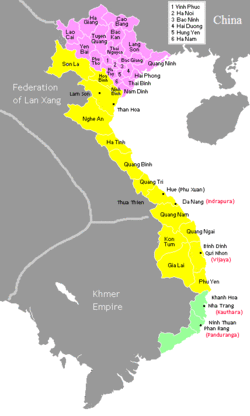- Mac Dang Dung
-
Mạc Đăng Dung (Hán tự: 莫登庸 posthumous name Mạc Thái Tổ Hán tự: 莫太祖; 1483?-1541) was a king of Vietnam and the founder of the Mạc Dynasty. Previously a captain of the imperial guard (Praetorian Prefect equivalent) of one of the Lê Dynasty emperors, he gradually rose to a position of great power. Mạc eventually deposed the last Lê monarch and became a monarch himself.
Contents
From Bodyguard to Emperor
Mạc Đăng Dung got his start as a bodyguard to the cruel and depraved Monarch of Vietnam, Lê Uy Mục. Mạc Đăng Dung was famous for his strength and cunning. (For more information see the article on the Lê Dynasty). Note that while some sources claim Mạc Đăng Dung was a Confucian scholar (government administrator) this seems to be the result of confusion with another notable Vietnamese scholar whose family name was also Mac. Mạc Đăng Dung was a military man who rose through the ranks.[1]
Despite several assassinations (both Lê Uy Mục and his successor Lê Tương Dực were assassinated) Mạc Đăng Dung continued to gain power and rank in the military. With the enthronment of the young emperor Lê Chiêu Tông in 1516, a power struggle in the court ensued. On the one side was Mạc Đăng Dung and his supporters (Mac was now the top general of the armies of Vietnam). On the other side were two noble families of Vietnam, the Trịnh and the Nguyễn, led by Nguyễn Hoàng Du and Trịnh Duy Dai and Trịnh Duy Sản.
Around 1520, the power struggle broke into civil war. The young emperor fled south to Thanh Hoa Province along with the Trịnh and the Nguyen families. Mạc Đăng Dung soon proclaimed the king's younger brother, Prince Xuan, was now the true monarch of Vietnam and had him installed under the name Lê Cung Hoàng. Meanwhile, armies fought along the border of Thanh Hoa Province.
In 1524, forces loyal to Mạc Đăng Dung captured and executed the original emperor Lê Chiêu Tông along with the leaders of the revolt (Nguyễn Hoàng Du, Trịnh Duy Dai, and Trịnh Duy Sản). The revolt by the Trịnh and the Nguyễn was defeated for the moment.
Emperor Minh Duc
Three years later, in 1527, Mạc Đăng Dung removed and killed his figurehead lord and proclaimed that now he was the emperor of Vietnam under the name Minh Duc. Using ruthless methods, he forced the Lê officials to recognize his dynasty and he murdered the members of the Lê family who still remained in the north. Some government officials committed suicide rather than acknowledge Mạc Đăng Dung as emperor, but others fled south and joined the resistance.
Yet another rebellion was launched, this time under the leadership of Nguyễn Kim and his son-in-law Trịnh Kiểm. Appeals from the Trịnh and Nguyễn were made to the Chinese Ming court to send in an army to remove the usurper. However Mạc Đăng Dung, using submissive behavior and bribery, managed to obtain a temporary recognition of his rule from the Ming dynasty in 1528.
The murder of the Lê emperor provoked unrest and the Trịnh and the Nguyễn revolted against the rule of Mạc Đăng Dung. Nominally the Trịnh and the Nguyễn were fighting on behalf of another Lê emperor, Lê Trang Tông, but in reality, he (and all future Lê monarchs) had no power.
In 1529 Mạc Đăng Dung abdicated to his son, Mạc Đăng Doanh, thus establishing his dynasty.
Retirement and rule again
Mạc Đăng Dung lived on as a retired emperor while his son had to deal with the continuing revolt by the Trịnh and the Nguyen. His son was not the equal of his father and as a result of several defeats, he lost control of the provinces south of the Red River. In 1533, the Nguyễn-Trịnh army conquered the Winter Palace and proclaimed Lê Trang Tông the rightful ruler of Vietnam.
Adding to the problems of military defeats, an official Chinese delegation determined that Mạc Đăng Dung's usurpation was not justified and so, in 1537 a very large army was dispatched to VietNam under the pretense of restoring the Lê family to power. In the summer, with the Chinese invading the north, Dung's son Doanh died and so Dung resumed his former position as emperor.
Mạc Đăng Dung managed once again by skillful negotiation to parry the Chinese menace. The Chinese accepted him as ruler over a part of Vietnam while he claimed to accept Lê rule over the southern part of Vietnam. The Chinese withdrew north without fighting. But the Nguyễn and the Trịnh refused to accept this division and so the war continued in the south.
Mạc Đăng Dung finally died in 1541 and was succeeded by his grandson Phước Hải.
Despite the Chinese recognition and his rule over much of Vietnam, later Vietnamese historians question the legitimacy of his reign. The usurpation by Mạc Đăng Dung split the kingdom, with the Mạc Dynasty reigning in the north, and the Lê Dynasty continuing in the south, supported by the Trịnh Lords and the Nguyễn Lords.
Preceded by
Lê Chiêu TôngKing of Vietnam
1527-1529 again 1537-1541Succeeded by
Mạc Đăng Doanh and Phước HảiReferences
- ^ Vietnam, Trials and Tribulations of a Nation D. R. SarDesai, p37, 1988
- Coedes, G. (1962). The Making of South-east Asia. London: Cox & Wyman Ltd.
- Coins of Vietnam - with historical context
- A glimpse of Vietnamese History - not completely reliable
Categories:- Year of birth uncertain
- 1541 deaths
- Mạc Dynasty emperors
- People from Hai Phong
Wikimedia Foundation. 2010.

